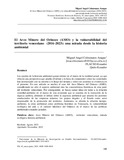Mostrar el registro sencillo del ítem
El arco minero del Orinoco (AMO) y la vulnerabilidad del territorio venezolano (2016-2023): una mirada desde la historia ambiental
| dc.rights.license | http://creativecommons.org/licenses/by-nc-sa/3.0/ve/ | es_VE |
| dc.contributor.author | Colmenares Araque, Miguel Ángel | |
| dc.date.accessioned | 2024-04-16T12:37:05Z | |
| dc.date.available | 2024-04-16T12:37:05Z | |
| dc.date.issued | 2024-04-16 | |
| dc.identifier.issn | ISSN 1690-4818 | |
| dc.identifier.uri | http://www.saber.ula.ve/handle/123456789/50426 | |
| dc.description.abstract | Los aportes de la historia ambiental ganan terreno en el marco de la realidad actual, ya que ofrecen una perspectiva que amplía el debate a la hora de comprender cómo las sociedades han interactuado con su entorno a lo largo del tiempo y cómo ese accionar se evidencia en el presente. En este artículo se analiza el caso del Arco Minero del Orinoco (AMO), considerando no sólo el aspecto ambiental sino las características históricas de esta parte del territorio venezolano. Por consiguiente, se busca sumar ideas en torno a la relación sociedad-ambiente en el marco de una economía que se sustenta en la extracción de la riqueza aurífera, abriendo el debate sobre la urgencia ambiental que arrastra los patrones conductuales de las empresas mineras, los grupos ilegales y el Estado como actor responsable de la protección del territorio. Asimismo, se aborda la relación tiempo-ambiente, la crisis ambiental como problema histórico en Venezuela, la vulnerabilidad ecológica del país y el carácter histórico del Orinoco en el marco de las políticas ambientales estatales actuales. Recibido: Agosto, 2023 / Aprobado: Noviembre, 2023 | es_VE |
| dc.language.iso | es | es_VE |
| dc.publisher | SaberULA | es_VE |
| dc.rights | info:eu-repo/semantics/openAccess | es_VE |
| dc.subject | Arco minero del Orinoco (AMO) | es_VE |
| dc.subject | Territorio venezolano | es_VE |
| dc.subject | Mirada ecológica | es_VE |
| dc.subject | Historia ambiental | es_VE |
| dc.title | El arco minero del Orinoco (AMO) y la vulnerabilidad del territorio venezolano (2016-2023): una mirada desde la historia ambiental | es_VE |
| dc.title.alternative | The Orinoco mining arc (OMA) and the vulnerability of Venezuelan territory (2016-2023): a look from environmental history | es_VE |
| dc.type | info:eu-repo/semantics/article | es_VE |
| dc.description.abstract1 | The contributions of environmental history gain ground within the framework of current reality, since they offer a perspective that broadens the debate when it comes to understanding how societies have interacted with their environment over time and how this action is evident in the present. This article analyzes the case of the Orinoco Mining Arc (OMA), considering not only the environmental aspect but also the historical characteristics of this part of the Venezuelan territory. Consequently, we seek to add ideas about the society-environment relationship within the framework of an economy that is based on the extraction of gold wealth, opening the debate on the environmental urgency that drags down the behavior patterns of mining companies, illegal groups and the state. as an actor responsible for the protection of the territory. Likewise, the time-environment relationship, the environmental crisis as a historical problem in Venezuela, the ecological vulnerability of the country and the historical character of the Orinoco are addressed within the framework of current state environmental policies. | es_VE |
| dc.description.colacion | 100-123 | es_VE |
| dc.description.email | procesoshistoricos.ce@gmail.com | es_VE |
| dc.description.email | macolmenaresfl@flacso.edu.ec | es_VE |
| dc.description.frecuencia | Semestral | |
| dc.description.paginaweb | http://www.saber.ula.ve/procesoshistoricos/ | |
| dc.identifier.depositolegal | pp200302ME1486 | |
| dc.publisher.pais | Venezuela | es_VE |
| dc.subject.institucion | Universidad de Los Andes | es_VE |
| dc.subject.keywords | Orinoco mining arc (OMA) | es_VE |
| dc.subject.keywords | Venezuelan territory | es_VE |
| dc.subject.keywords | Ecological perspective | es_VE |
| dc.subject.keywords | Environmental history | es_VE |
| dc.subject.seccion | Revista Procesos Históricos: Artículos | es_VE |
| dc.subject.tipo | Artículos | es_VE |
| dc.type.media | Texto | es_VE |
| dc.identifier.doi | https://doi.org/10.53766/PROHIS/2024.45.06 | es |
| dc.contributor.orcid | http://orcid.org/0000-0003-3353-6875 |
Ficheros en el ítem
Este ítem aparece en la(s) siguiente(s) colección(ones)
-
Procesos Históricos - Nº 045, Año XXII
Enero-Junio 2024


